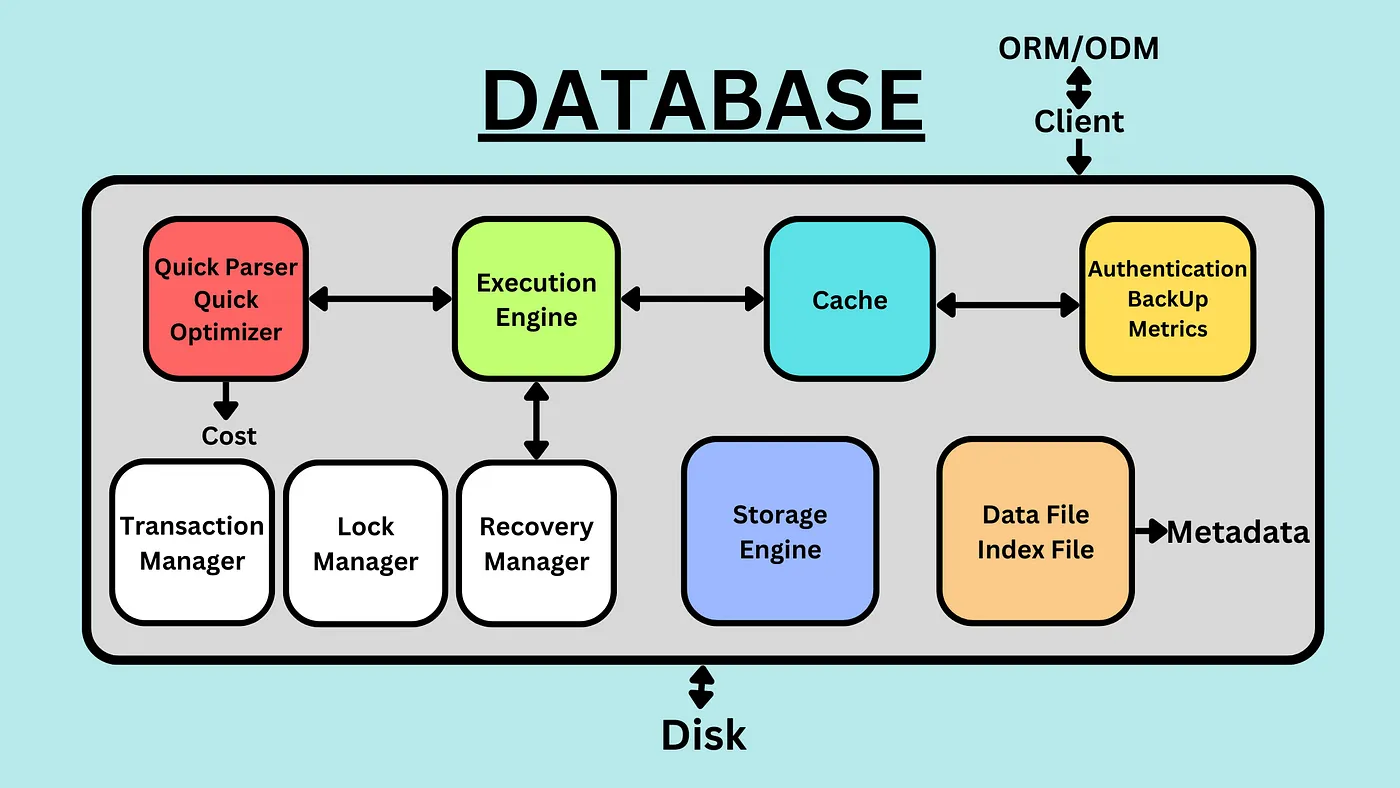Types of Databases(Autonomous/Non Autonomous/Federation/Multidatabase)
 Uvindu Abeywardhana
Uvindu Abeywardhana
1. Homogeneous DDBMS can be divided in to two parts
i. Autonomous DBMS and
ii. Non Autonomous DBMS
➢ Autonomous DBMS An autonomous database is a cloud database that uses machine learning to automate database tuning, security, backups, updates, and other routine management tasks traditionally performed by DBAs. Unlike a conventional database, an autonomous database performs all these tasks and more without human intervention. One such database service is Oracle Autonomous Database, which provides a completely managed, self-driving database in the Oracle Cloud. Similar autonomous database services are also provided by other cloud providers, including Google Cloud Platform (GCP), Microsoft Azure, and Amazon Web Services (AWS).
• How an Autonomous Database Works An autonomous database leverages AI and machine learning to provide full, end-to-end automation for provisioning, security, updates, availability, performance, change management, and error prevention. In this respect, an autonomous database has specific characteristics.
• It is self-driving All database and infrastructure management, monitoring, and tuning processes are automated. DBAs can now focus on more important tasks, including data aggregation, modeling, processing, governance strategies, and helping developers use in-database features and functions with minimal changes to their application code.
• It is self-securing Built-in capabilities both external attacks and malicious internal users. This helps eliminate concerns about cyberattacks on unpatched or unencrypted databases.
• It is self-repairing This can prevent downtime, including unplanned maintenance. An autonomous database can require fewer than 2.5 minutes of downtime per month, including patching.
➢ Advantages of an Autonomous DBMS There are several benefits of an autonomous database.
• Maximum database uptime, performance, and security―including automatic patches and fixes
• Elimination of manual, error-prone management tasks through automation
• Reduced costs and improved productivity by automating routine tasks An autonomous database also allows an organization to refocus database management staff on higher-level work that creates greater business value, such as data modeling, assisting programmers with data architecture, and planning for future capacity. In some cases, an autonomous database can help a business save money by reducing the number of DBAs needed to manage its databases or by redeploying them to more strategic tasks.
➢ Disadvantages of non autonomous DBMS
▪ Data Sovereignty and Compliance: Depending on the cloud provider and location of data centers, organizations may face challenges related to data sovereignty and compliance with regional data protection regulations. Understanding where data is stored and processed is crucial for compliance.
▪ Compatibility Issues: Existing applications or tools that were designed for traditional databases may not seamlessly integrate with or fully leverage the features of autonomous databases. Ensuring compatibility and making necessary adjustments may be required.
▪ Security Concerns: While autonomous databases often come with advanced security features, organizations may still have concerns about the security of their data in a cloud environment. Issues such as data breaches, unauthorized access, or other security vulnerabilities may arise.
➢ Non autonomous DBMS A non-autonomous database, sometimes referred to as a traditional or manual database, is a database system that relies on manual intervention for various administrative tasks and management activities. In contrast to autonomous databases, non-autonomous databases require database administrators (DBAs) and IT personnel to perform tasks such as configuration, tuning, backups, security management, and scaling.
➢ Advantages of Non autonomous DBMS
▪ Cost Considerations: Depending on the specific requirements and resource usage patterns, nonautonomous databases may offer cost advantages in terms of licensing, especially for smaller-scale deployments or when dealing with predictable workloads. ▪ Offline Maintenance: When it comes to offline maintenance, non-autonomous databases might be more adaptable. Businesses can plan maintenance windows during times of low demand to carry out operations such as software updates, patching, or schema modifications without interfering with real-time operations.
▪ Customization and Control: Non-autonomous databases provide database administrators (DBAs) with a high level of control over configuration settings, performance tuning, and security measures. This customization allows organizations to tailor the database environment to specific requirements and business needs.
➢ Disadvantages of non autonomous DBMS
▪ Complexity and Learning Curve: Managing nonautonomous databases often requires a deep understanding of the database system, including its architecture, configuration settings, and optimization techniques. This complexity can result in a steep learning curve for database administrators (DBAs), especially when dealing with intricate or large-scale systems.
▪ Security Risks: The manual configuration of security measures in non-autonomous databases can lead to oversights and vulnerabilities. Ensuring robust security practices requires careful attention to detail and ongoing vigilance.
▪ Slower Response to Changing Workloads: Nonautonomous databases may have limitations in adapting quickly to fluctuating workloads. Scaling resources and adjusting configurations manually can result in slower response times compared to autonomous systems that can automatically adapt to changing demands.
▪ Less Adaptive to Modern Cloud Environments: Nonautonomous databases may face challenges when migrating to or integrating with modern cloud environments. They may not fully leverage the benefits of cloud services, such as elasticity, scalability, and automated management
2. Heterogeneous database can be divided in to two parts of Federated DBMS o Multidatabases DBMS ..
• Federated DBMS A federated database system is a type of meta-database management system (DBMS), which transparently integrates multiple autonomous database systems into a single federated database. The constituent databases are interconnected via a computer network and may be geographically decentralized. Since the constituent database systems remain autonomous, a federated database system is a contrastable alternative to the (sometimes daunting) task of merging together several disparate databases. A federated database, or virtual database, is the fully integrated, logical composite of all constituent databases in a federated database system. McLeod and Heimbigner[1] were among the first to define a federated database system, as one which "define[s] the architecture and interconnect[s] databases that minimize central authority yet support partial sharing and coordination among database systems".[1] Through data abstraction, federated database systems can provide a uniform user interface, enabling users and clients to store and retrieve data in multiple noncontiguous databases with a single query -- even if the constituent databases are heterogeneous. To this end, a federated database system must be able to decompose the query into subqueries for submission to the relevant constituent DBMS's, after which the system must composite the result sets of the subqueries. Because various database management systems employ different query languages, federated database systems can apply wrappers to the subqueries to translate them into the appropriate query languages.
• Multidatabases A multidatabase management system (MDBMS) is a type of database management system that provides the capability to manage and integrate multiple, possibly heterogeneous, databases within a single environment. The goal of an MDBMS is to allow users and applications to interact with and query data from multiple databases as if they were a single, unified database.
Subscribe to my newsletter
Read articles from Uvindu Abeywardhana directly inside your inbox. Subscribe to the newsletter, and don't miss out.
Written by

Uvindu Abeywardhana
Uvindu Abeywardhana
I am undergraduate student of the University of Sri Jayewardenepura. I have strong technical skills as well as excellent interpersonal skills that enable me to interact with a team. My greatest desire in life is to further develop my skills and share my knowledge with other people and organizations.I'm seeking position as technologist with reputable company where I can utilize my analytical, technical skills and knowledge which can further help the development of the company.